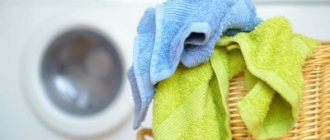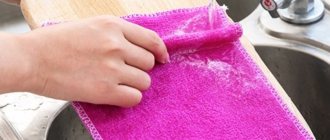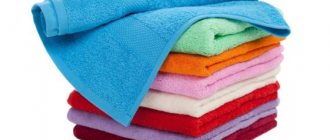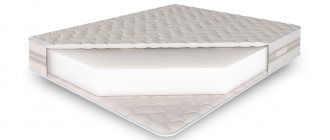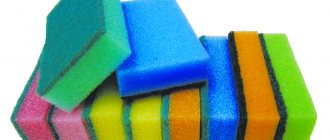A towel is the same personal hygiene product as a toothbrush, razor or slippers. It is recommended to change it every year, as the fabric wears out and dries worse, as a result of which bacteria actively multiply on it. How often should towels be washed?
It is clear that things with stains and a bad smell definitely need to be washed, but it is better not to let the towel get into this state. The frequency of washing depends on what the product is intended for.
Kitchen towel: what is the danger?
A towel is an indispensable accessory in any household. It is used to dry hands, polish plates and other cutlery to a shine, and remove unsightly water stains from them. It is used to dry washed fruits and vegetables, and sometimes to brush crumbs off the table with it, and then, with a clear conscience, hang it on the stove handle or a hook on the wall so that the fabric dries.
- Northern pension for women with two children - calculation procedure
- How to protect money from scammers
- 8 Simple Ways to Relieve Joint Pain
Answers to frequently asked questions
There are several questions regarding washing, the answers to which even experienced housewives often seek; experts have tried to give detailed answers to them:
- Why do towels become stiff over time? There are several main reasons for this problem, for example, washing in water of high hardness. This result can also be caused by using low-quality powder, washing at very high temperatures, bleaching with chlorine, poor rinsing of items, spinning at high speeds, and frequent ironing.
- How to soften fabric? You can reduce the water hardness by adding vinegar to it, use a quick wash mode, spin clothes at a speed of 400 rpm, use double or triple rinses. And also choose an environmentally friendly laundry detergent that does not contain chlorine or phosphates. It is desirable that it be liquid, since the powder is very difficult to dissolve and rinse out. You can soften terry towels by placing special balls in the washing machine drum.
- Is it possible to get rid of the unpleasant odor from towels? If items have been used for a long time or are constantly damp or left in the dirty laundry basket for a long time, they can actually begin to emit an unpleasant odor. If regular washing does not help get rid of it, try boiling them with laundry soap, then rinsing them in water with essential oil. Or soak for 8-10 hours in water with the addition of soda and vinegar, then wash as usual. If this does not help, you can use a special washing liquid that effectively removes unpleasant odors, for example, OXICLEAN Freshness.
- Does bleaching harm fabrics? Bleaching does not harm the fibers if a chlorine-free product is used. The desired effect can be achieved by using a solution made from 5 liters of water, 1 tablespoon of ammonia and 25 ml. hydrogen peroxide. Products need to be soaked in the solution for 30 minutes and then washed. Or you can soak things in ice water to which salt has been added (2 tablespoons per 1 liter of water). You can also buy commercial chlorine-free bleach.
And the last question on which opinions differ: should towels be ironed? Our experts believe that products used to wipe the body, hands, and face do not need to be ironed. Otherwise, they become hard, lose their hygroscopicity, that is, they absorb water worse. To make the product look neat and not wrinkle, just shake it after washing and straighten it with your hands on a rope or dryer bar. But towels used in the kitchen can be ironed, since additional disinfection would not interfere with them, and besides, the housewives try not to put wrinkled things on public display.
Latest Research
The object of research was one hundred kitchen towels. They were in use for a whole month, then bacteriological studies were carried out on them to discover what microorganisms inhabited this piece of kitchen textile. After such active use, many pathogenic microorganisms settled on the towels, but their number was influenced by several factors:
- number of family members who used towels;
- the type of diet that users followed;
- what functions were the towels used for?
The results of the study are impressive: almost half of the subjects studied showed the growth of harmful bacteria. Of the 49%, 36.7% had enterococci, 36.7% coliform bacteria, and 14.3% had Staphylococcus aureus on them. It is worth noting that the latter two types of bacteria were largely represented in areas where a vegetarian diet was not followed.
The number of bacteria was especially huge in large families with many children. In small families, towels were “safer.” Another fact is that there were more microorganisms on those towels that were used for a variety of purposes:
- wiped hands and dishes;
- used as oven mitts to remove hot baking sheets from the oven;
- wiped surfaces.
Towels that were used only for their intended purpose - to dry hands, dry vegetables - did not become such a desirable haven for dangerous bacteria. Scientists also found that far fewer organisms live on dry textiles than on wet textiles.
- How to buy plane tickets profitably - early booking, buying from low-cost airlines and aggregators
- Fitball exercises
- Which sanatoriums offer free trips to pensioners - a list of the best
It is important to be responsible about the cleanliness and use of kitchen towels. Wet has no place in the kitchen. Also, do not use one towel for many different purposes. Particular attention to hygiene in the kitchen should be paid to those families where there are many children and elderly people.
How many towels should you have in your home?
Towels are something you can never have too many of. Considering that they need to be washed and renewed frequently, it is advisable that you have a supply of towels. We also recommend purchasing several towels of different sizes for guests.
To maintain personal hygiene you will need towels:
- For the face - small towels that are convenient for wiping your neck and face while washing. It is undesirable to use them for other purposes, since bacteria and pathogens may appear on the fabric of the towel, causing various rashes.
- For hands - small towels that can be placed not only in the bathroom, but also in the kitchen. They are also convenient to take with you on a trip.
- For feet – products intended for wiping feet. Do not under any circumstances wipe your hands, face, or body with such towels.
- For intimate hygiene, designed to care for delicate areas.
- For the body - large fluffy towels in which you can completely wrap yourself and completely dry yourself after a shower or bath.
How often should you change kitchen towels?
Scientists have discovered an unpleasant truth about things that are familiar to us, but there is no need to get upset and panic. Yes, towels can be a real breeding ground for infection, but you can ensure that you can use them without fear. These methods are simple and we can all do them.
You just need to follow simple rules and get into the habit of paying special attention to kitchen textiles. It is worth listening to tips on how often to change kitchen towels:
- Towels in the kitchen and bathrooms should be changed every day. This is essential if you want to protect yourself from foodborne pathogens and other bacteria. For example, you need to change towels every time you dry dishes and wipe down surfaces after dinner.
- Do not throw wet towels into the basket with dirty clothes. Let them dry first, and then you can put them in the basket, or directly into the machine and wash them at the highest temperature.
- You cannot wash kitchen towels with clothes - this is a guaranteed way to “colonize” them with unnecessary bacteria.
What can result from untimely replacement of textiles?
Dirty laundry is not only a lack of comfort in the home, but also a risk of harming your health. Particular attention should be paid to replacing sheets and pillowcases; they are most susceptible to contamination due to close contact with the human body. They retain dead skin particles, sebum and sweat. If there are animals in the house, then fur and scales of animal epithelium are added to all these contaminants.
All this contributes to the proliferation of dust mites. It is impossible to see it with the naked eye, but the consequences in the form of allergic rashes and dermatitis can appear quite quickly. A dirty bed increases the risk of developing respiratory diseases. The accumulated dust and microscopic debris enters the respiratory tract, which can even lead to the development of asthma.
The cleanliness of towels also needs to be constantly monitored, as well as the condition of the bathroom. There is a high level of humidity in the bath and not everyone sends their towels out to dry after taking a shower. Because of this, after just one use they may develop an unpleasant odor. It will only get worse - bacteria will begin to multiply, which can cause mold to appear. The longer linen and towels are used, the more difficult it is to wash them. Pollution eats in more and more every day, this is especially noticeable on light-colored fabrics. Due to irregular washing, textiles quickly lose their original appearance and become unusable.
Rules for caring for kitchen towels
Basic recommendations for the use and care of kitchen towels:
- Always change kitchen towels if they have been used to wipe down dishes or surfaces that have come into contact with raw meat.
- When washing towels, choose the longest wash cycle at the highest temperature. It is hot water that allows you to better wash out dirt from the fabric, and thus remove microorganisms.
- Do not use fabric softener when washing kitchen towels. It creates an invisible film on the surface of the fabric; contact with food should be avoided.
- Rinse the fabric thoroughly. Cleaning agents may not be easily rinsed out of the fibers. Don't be lazy, turn on an additional rinse cycle.
- Make sure your towels are dry before throwing them into the laundry basket. Warm, dark, damp environments are a haven for harmful microorganisms. In such conditions, the towel will smell musty, and mold may even appear on it. The best option is to let the towel dry overnight and put it in the wash in the morning.
- The more of these kitchen accessories you have, the more often you can afford to replace them. So take a look at your kitchen towels and add new items to your collection.
Washing Tips
The washing mode must be selected based on the manufacturer’s recommendations indicated on the label of the textile product, or based on the composition.
We recommend: Rules for caring for fleece and features for washing capricious items
The optimal temperature when washing towels is 40–50 degrees. This heating of water is quite enough to kill bacteria and germs. If there are stubborn stains, you can increase the temperature to 70 degrees.
Do not forget that not only the service life and appearance of the product, but also the health of your family members depends on a competent approach to the issue of washing towels.
Pillow
No matter what filling your favorite pillow is made of, dust still accumulates in it, which attracts ticks and bedbugs. The pillow can last no more than five years.
There are special companies that clean pillows by blowing and sifting the filling from dust and pests. They also have a variety of napkins treated with a bactericidal agent. You should not use such cleanings often, as sometimes they cost no less than a new pillow.
Personal hygiene items have a great impact on human health. One truth comes to mind: you can’t buy health. In this case, you can help your health: you should not skimp on personal hygiene items. It is necessary to use them correctly, as they are an integral part of a healthy lifestyle.
How often do you need to change personal hygiene items?
Many people think that personal care products must be used before their expiration date. Some people change them more often, while others use them for too long. The accuracy of the consumer does not matter here; each thing has its own service life. Let's look at the most basic personal hygiene items that can harm our health if used incorrectly.
For face
Face towels often cause skin problems: acne, allergic rashes and various types of inflammation. They need to be changed daily or every other day.
For those with problem skin, it is better to avoid them completely. It is much more beneficial for inflamed skin to dry naturally, and the risk of additional infection will be minimal. If necessary, you can use soft paper napkins.
The acceptable size of a face towel is 100 x 50 cm.
Shaving machines
A disposable machine should not be used more than once. Disposable machines are designed in such a way that it is almost impossible to wash them. If you use such machines repeatedly, there is a risk of inflammation of the hair follicles as a result of the penetration of staphylococci.
Machines with replaceable blades, which have a special indicator strip, can be used for no more than one month. Such blades are located at a sufficient distance from each other, which simplifies the rinsing procedure. As soon as the indicator changes color, the blade must be replaced.
Why do towels need to be washed?
In the bathroom, with a towel we mainly remove excess moisture from the surface of our (or not our) body. ... And you can fight all these “living creatures” only by timely, regular and proper washing of towels.
Interesting materials:
How to pump your abs correctly and safely? How to pump up your abs correctly and quickly? How to stand in the plank correctly and for a long time? How to stand on the plank correctly and for a long time? How to look for truffles in Russia? How to use Calgon correctly? How to use film wax correctly? How to correctly measure the length of a curtain? How to correctly measure butt volume? How to correctly measure a woman's body parameters?
Factors to consider when purchasing towels
Photo by Pixabay
Here we will provide the most useful tips that housewives may need when buying high-quality and comfortable towels.
- A good towel is made from cotton thread or linen, cotton fabric. Today you can find towels made from microfiber - they are soft, absorb moisture well, very beautiful and light, but not as durable as towels made from natural materials. Cotton fiber from Egypt has received worldwide recognition - towels made from it are the best.
- Do not buy towels made from mixed fabrics containing up to 50% synthetic fiber. These towels are very pleasant to the touch, beautiful and bright, hold their shape well, are lightweight, and dry quickly. But when wiped, they do not absorb moisture well and “creak” across the body, leaving an unpleasant sensation. In addition, such low quality towels can shed a lot.
- If you are buying towels for travel, opt not for terry towels, but for waffle towels. These towels are much lighter and smaller in volume, but they wipe away moisture very well and are also easy to wash.
- The quality of terry towels (terry sheets and terry robes) is assessed by their density. Towels with a density below 320 g per m2 do not absorb as much moisture as those with a higher density; they quickly become wet, lose their shape, fade, and wear out. If you are buying towels for a bath or shower, bath or sauna, choose samples with a density of at least 470 g per m2. Thicker towels are even stronger, but they are more difficult to wash and dry.
- The pile of terry towels (as well as terry robes) can also vary in height. Too short a towel pile, from 3.5 mm, makes this product quite hard over time, it wears out faster. The very long pile of a terry towel - from 7-8 mm or more, tangles the hair, is pulled out in loops, clings to everything, and accordingly - quickly loses its fluffy beautiful appearance. The most optimal length of terry towel pile is from 4 mm to 5 mm.
- For use in the kitchen, it is better to buy waffle or linen towels rather than terry towels - they are easier to wash and dry faster, they are easy to iron, they retain their appearance longer, absorb moisture well, and wipe dishes without leaving lint on them.
- When purchasing, look carefully at the product labeling. If it says “cotton 100% (M)”, then this is a product with the inclusion of synthetic fibers in cotton. If the marking indicates (PC), the product contains polyestercotton artificial fiber.
- When purchasing, carefully inspect the product - it should be evenly colored, on both sides, and have a silky surface. Pay attention to the smell of the product - normally, a high-quality towel should not smell of chemicals.
- After running your hand over the surface of the product, look at your palm to see if it has become stained with the dyes included in the towel. If the seller allows, it is best to run a white napkin over the surface of the towel - the poor-quality color will be “obvious” immediately.
- If you see soybean fiber (“SPF”, soybean protein fiber) in the towel, then you can safely purchase this product. This type of fiber was developed in South Korea, it contains a substance resulting from the processing of soybean proteins. This fiber dries faster than cotton, and it absorbs moisture much better. Products made from soy fiber cannot be confused with any others - they are very soft, pleasant to the touch, similar to cashmere or silk. Such products must be washed at a temperature no higher than 60 degrees, and then they do not lose their shape and their wonderful properties for a very long time. Soy fiber is a means of preventing inflammation on the skin and aging of the skin.
- Currently, terry products are popular, which contain special fibers - lyocell (Lenzing Lyocell Micro). This fiber is made from eucalyptus wood, it absorbs moisture better, dries much faster than cotton, does not acquire any odors, and does not “absorb” dust particles. Towels with lyocell fiber are very soft to the touch, reminiscent of silk fabric. These towels are washed at a temperature not exceeding 60°C.
Bath
Recommended size 150 x 100 cm or 140 x 70 cm.
Bath towels can be changed every three days, but only if they are completely dry after use. This is not so easy to achieve - they are dense and take quite a long time to dry. High humidity leads to rapid proliferation of the most dangerous bacteria between the fibers. A regular bath towel can simultaneously detect dust mites, yeast, mold, and E. coli.
This is because it is an ideal breeding ground for the growth of harmful flora: more than one million of our skin cells settle on a bath towel every day.
The health of all family members is of great importance. If someone is sick with the flu or other infectious disease, all of their towels must be strictly individual and must be replaced daily.



